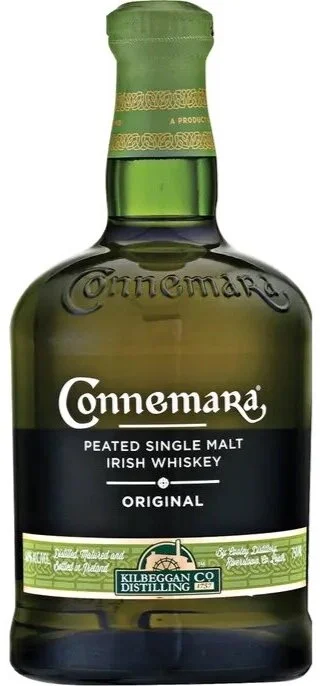Connemara Peated Irish Whiskey Review
Hold up…a peated Irish Whiskey? That’s right - Kilbeggan’s Connemara Whiskey is the first (though I don’t think they’re the only anymore) peated Irish Single Malt on the market. Despite peat being native to Ireland, Connemara imports its peat from Scotland. I have a request out to Connemara to ask where from, if they’ll tell.
With the stereotype of all Scotch being peated (not remotely the case), it’s worth diving into exactly what peat is, why it’s used, and why it’s nearly unheard of in Irish Whiskey. After all, only a dozen miles separate Ireland and Scotland, yet their styles are remarkably different, particularly when it comes to the use of peat.
First off, what is peat? Peat is decomposed and compressed organic matter, anaerobic, and fully hydrated (i.e. it’s wet). Peat is found all over the world, from Scotland to Japan to the US. It’s also a semi-renewable biofuel (it will renew, but takes a few thousand years to develop).
When it comes to Scotch and Irish Whiskey, though, the important thing to remember is what peat was used for most: fuel. In Scotland, particularly in the Islay and Islands regions, there are few-to-no trees (and the English Isles aren’t exactly known for their fossil fuel reserves until you get far up north).
Therefore, families in these regions would dig up peat from a bog, dry it, and burn it as fuel, just as those in wooded areas would cut a tree, dry the wood, and burn that. In areas where wood fuel was more available, like the Scottish Highlands, peat is to this day less prominent in whiskies produced there.
Peat is heavily characterized by the vegetation and, to a lesser extent, the animal life that composes it. If you compare, for example, Islay peat (Laphroaig, Ardbeg) with Orkney peat (Highland Park) or Isle of Jura peat, each would smell and taste different.
Islay peat, being made up of seaweed, saltwater vegetation, and low-lying plants, will impart salinity, iodine-like notes, and earthy smoke when burned. Orkney - where trees do not grow because the winds regularly reach 100 mph - is mainly heather peat, imparting vegetal and only mild saline notes. Peat is one of the few components in whiskey for which no one could argue against terroir - it is fundamentally shaped by its environment, and no amount of distillation will change that.
Anyway - why Connemara, and why only one peated Irish Whiskey? Because Kilbeggan and the founder of Isle of Arran - a Scottish distillery that, you guessed it, uses peat - were connected, and thus a unique Irish single malt was born. Unlike peated Scotch whisky, which is often peated to 30-40 ppm (parts per million of phenols), Connemara is peated around 14-15 ppm. The result is a peated single malt that isn’t so overtaken by smoke that you can’t taste the whiskey underneath.
Connemara Peated Single Malt Irish Whiskey: Specs
Classification: Single Malt Irish Whiskey
Origin: Kilbeggan Co. Distilling (Cooley Distillery)
Mashbill: Undisclosed
Proof: 80 (40% ABV)
Age: NAS
Location: Ireland
Connemara Peated Irish Whiskey Price: $50
Connemara Peated Irish Whiskey Review: Tasting Notes
Eye: Pale honey.
Nose: Very smoky, slight salty undertones but not overwhelmingly peaty otherwise. Some malt underneath after a few sniffs.
Palate: Smoke up front - on first sip, I thought this would equal some scotch ppm levels, but subsequent sips reduce the pettiness and let the Irish character come through - herbal honey. Mouthfeel is oily and coating, peat remains.
Finish: Short, mostly reverting to the peat.
Overall: May not be my favorite, and if I’m going for something peated I’ll always go Highland Park first, but this is still an interesting take on Irish Whiskey. I really want to know where in Scotland the peat comes from.
Final Rating: 5.8
10 | Insurpassable | Nothing Else Comes Close (Blanton’s Straight from the Barrel)
9 | Incredible | Extraordinary (GTS, Elijah Craig Barrel Proof B518 and B520)
8 | Excellent | Exceptional (12+YO MGP Bourbon, Highland Park Single Barrels)
7 | Great | Well above average (Blanton’s Original, Old Weller Antique, Booker’s)
6 | Very Good | Better than average (Four Roses Small Batch Select, Knob Creek 14+ YO Picks)
5 | Good | Good, solid, ordinary (Elijah Craig Small Batch, Buffalo Trace, Old Grand-Dad Bottled-in-Bond)
4 | Sub-par | Many things I’d rather have (A.D. Laws Four Grain, Compass Box “Oak Cross”)
3 | Bad | Flawed (Iron Smoke Bourbon, Balcones)
2 | Poor | Forced myself to drink it (Buckshee Bourbon and Rye)
1 | Disgusting | Drain pour (Virginia Distilling Co. Cider Cask)










